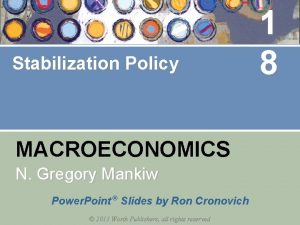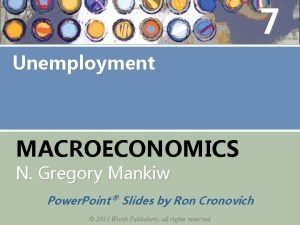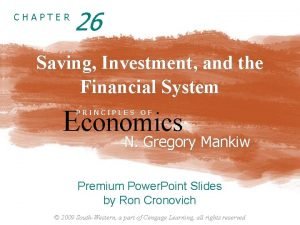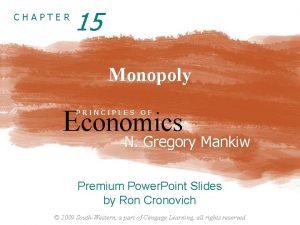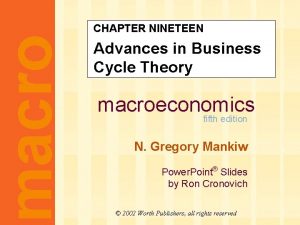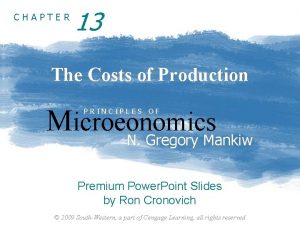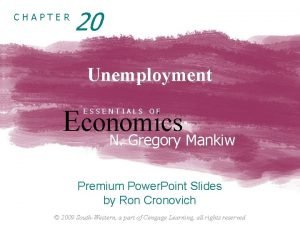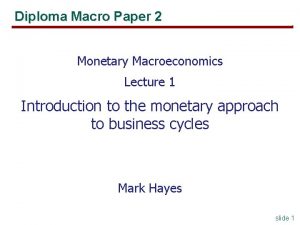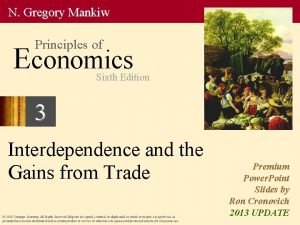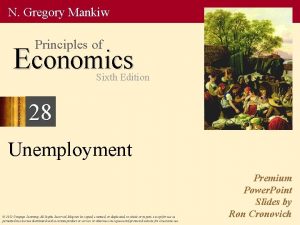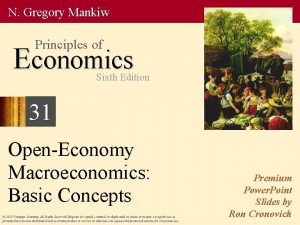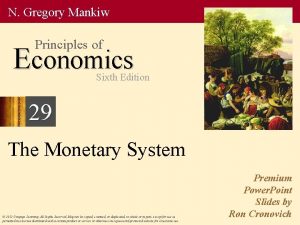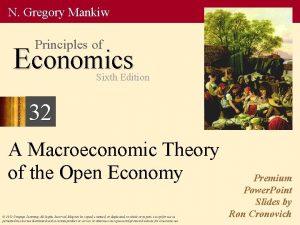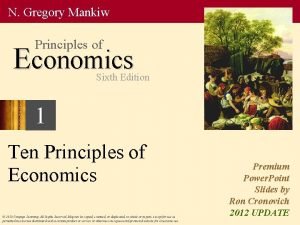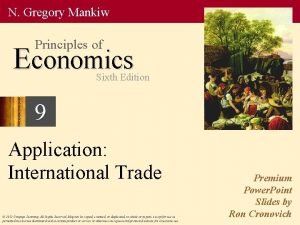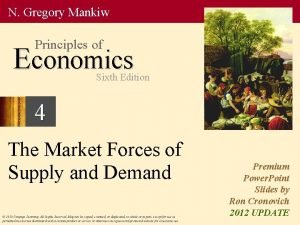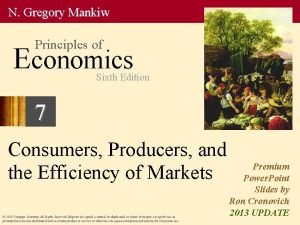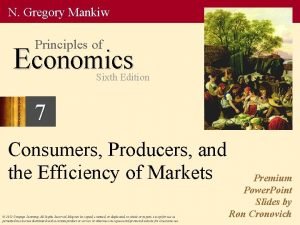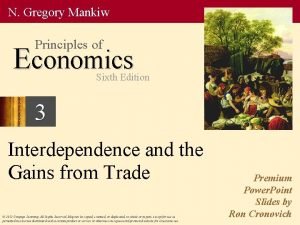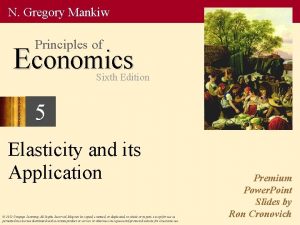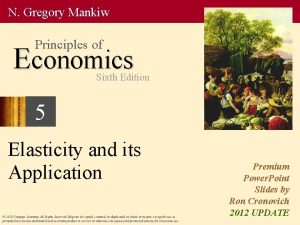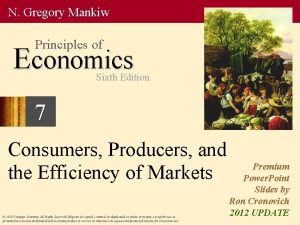N Gregory Mankiw Principles of Economics Sixth Edition

















- Slides: 17

N. Gregory Mankiw Principles of Economics Sixth Edition 2 Thinking Like an Economist © 2012 Cengage Learning. All Rights Reserved. May not be copied, scanned, or duplicated, in whole or in part, except for use as permitted in a license distributed with a certain product or service or otherwise on a password-protected website for classroom use. Premium Power. Point Slides by Ron Cronovich

Our First Model: The Circular-Flow Diagram § The Circular-Flow Diagram: a visual model of the economy, shows how dollars flow through markets among households and firms § Two types of “actors”: § households § firms § Two markets: § Product Market § Factor Market © 2012 Cengage Learning. All Rights Reserved. May not be copied, scanned, or duplicated, in whole or in part, except for use as permitted in a license distributed with a certain product or service or otherwise on a password-protected website for classroom use.

Factor Market § Factors of production: the resources the economy uses to produce goods & services, including § labor § land § capital (buildings & machines used in production) © 2012 Cengage Learning. All Rights Reserved. May not be copied, scanned, or duplicated, in whole or in part, except for use as permitted in a license distributed with a certain product or service or otherwise on a password-protected website for classroom use.

FIGURE 1: The Circular-Flow Diagram Revenue G&S sold Markets for Goods & Services Firms Factors of production Wages, rent, profit Spending G&S bought Households Markets for Factors of Production Labor, land, capital Income

Our Second Model: The Production Possibilities Frontier § The Production Possibilities Frontier (PPF): a graph that shows the combinations of two goods the economy can possibly produce given the available resources and the available technology § Example: § Two goods: computers and wheat § One resource: labor (measured in hours) § Economy has 50, 000 labor hours per month available for production. © 2012 Cengage Learning. All Rights Reserved. May not be copied, scanned, or duplicated, in whole or in part, except for use as permitted in a license distributed with a certain product or service or otherwise on a password-protected website for classroom use.

PPF Example § Producing one computer requires 100 hours labor. § Producing one ton of wheat requires 10 hours labor. Employment of labor hours Production Computers Wheat A 50, 000 0 500 0 B 40, 000 10, 000 400 1, 000 C 25, 000 250 2, 500 D 10, 000 40, 000 100 4, 000 E 0 50, 000 0 5, 000

PPF Example Production Point on Comgraph puters Wheat A 500 0 B 400 1, 000 C 250 2, 500 D 100 4, 000 E 0 5, 000 E D © 2012 Cengage Learning. All Rights Reserved. May not be copied, scanned, or duplicated, in whole or in part, except for use as permitted in a license distributed with a certain product or service or otherwise on a password-protected website for classroom use. C B A 6

The PPF and Opportunity Cost § Recall: The opportunity cost of an item is what must be given up to obtain that item. § Moving along a PPF involves shifting resources (e. g. , labor) from the production of one good to the other. § Society faces a tradeoff: Getting more of one good requires sacrificing some of the other. § The slope of the PPF tells you the opportunity cost of one good in terms of the other. © 2012 Cengage Learning. All Rights Reserved. May not be copied, scanned, or duplicated, in whole or in part, except for use as permitted in a license distributed with a certain product or service or otherwise on a password-protected website for classroom use.

The PPF and Opportunity Cost – 1000 slope = = – 10 100 The slope of a line equals the “rise over the run, ” the amount the line rises when you move to the right by one unit. Here, the opportunity cost of a computer is 10 tons of wheat. © 2012 Cengage Learning. All Rights Reserved. May not be copied, scanned, or duplicated, in whole or in part, except for use as permitted in a license distributed with a certain product or service or otherwise on a password-protected website for classroom use.

PPF and Opportunity Cost In which country is the opportunity cost of cloth lower? FRANCE ENGLAND

Answer England, because its PPF is not as steep as France’s. FRANCE ENGLAND

At point A, most workers are producing beer, even those who are better suited to building bikes. Beer Why the PPF Might Be Bow-Shaped A At A, opp. cost of mtn bikes is low. So, do not have to give up much beer to get more bikes. Mountain Bikes © 2012 Cengage Learning. All Rights Reserved. May not be copied, scanned, or duplicated, in whole or in part, except for use as permitted in a license distributed with a certain product or service or otherwise on a password-protected website for classroom use.

At B, most workers are producing bikes. The few left in beer are the best brewers. Beer Why the PPF Might Be Bow-Shaped Producing more bikes would require shifting some of the best brewers away from beer production, causing a big drop in beer output. © 2012 Cengage Learning. All Rights Reserved. May not be copied, scanned, or duplicated, in whole or in part, except for use as permitted in a license distributed with a certain product or service or otherwise on a password-protected website for classroom use. At B, opp. cost of mtn bikes is high. B Mountain Bikes

Microeconomics and Macroeconomics § Microeconomics is the study of how households and firms make decisions and how they interact in markets. § Macroeconomics is the study of economy-wide phenomena, including inflation, unemployment, and economic growth. © 2012 Cengage Learning. All Rights Reserved. May not be copied, scanned, or duplicated, in whole or in part, except for use as permitted in a license distributed with a certain product or service or otherwise on a password-protected website for classroom use.

The Economist as Policy Advisor § As scientists, economists make positive statements, which attempt to describe the world as it is. § As policy advisors, economists make normative statements, which attempt to prescribe how the world should be. § Positive statements can be confirmed or refuted, normative statements cannot. § Govt employs many economists for policy advice. E. g. , the U. S. President has a Council of Economic Advisors, which the author of this textbook chaired from 2003 to 2005.

Why Economists Disagree § Economists often give conflicting policy advice. § They sometimes disagree about the validity of alternative positive theories about the world. § They may have different values and, therefore, different normative views about what policy should try to accomplish. § Yet, there are many propositions about which most economists agree. © 2012 Cengage Learning. All Rights Reserved. May not be copied, scanned, or duplicated, in whole or in part, except for use as permitted in a license distributed with a certain product or service or otherwise on a password-protected website for classroom use.

Propositions about Which Most Economists Agree (and % who agree) § A ceiling on rents reduces the quantity and quality of housing available. (93%) § Tariffs and import quotas usually reduce general economic welfare. (93%) § The United States should not restrict employers from outsourcing work to foreign countries. (90%) § The United States should eliminate agriculture subsidies. (85%) © 2012 Cengage Learning. All Rights Reserved. May not be copied, scanned, or duplicated, in whole or in part, except for use as permitted in a license distributed with a certain product or service or otherwise on a password-protected website for classroom use.
 Principles of economics mankiw 9th edition ppt
Principles of economics mankiw 9th edition ppt Principles of economics mankiw 9th edition ppt
Principles of economics mankiw 9th edition ppt Principles of economics sixth edition
Principles of economics sixth edition Mankiw macroeconomics 9th edition
Mankiw macroeconomics 9th edition The sixth sheik's sixth sheep's sick
The sixth sheik's sixth sheep's sick Rubber baby buggy bumpers tongue twister lyrics
Rubber baby buggy bumpers tongue twister lyrics Principle of economics third edition
Principle of economics third edition Chapter 26 saving investment and the financial system
Chapter 26 saving investment and the financial system Chapter 15 monopoly
Chapter 15 monopoly Macroeconomics by mankiw
Macroeconomics by mankiw Tc fc vc example
Tc fc vc example Intermediate macroeconomics mankiw
Intermediate macroeconomics mankiw Mankiw slides
Mankiw slides Mankiw
Mankiw Biochemistry sixth edition 2007 w.h. freeman and company
Biochemistry sixth edition 2007 w.h. freeman and company Computer architecture a quantitative approach sixth edition
Computer architecture a quantitative approach sixth edition Automotive technology sixth edition
Automotive technology sixth edition Automotive technology sixth edition
Automotive technology sixth edition
